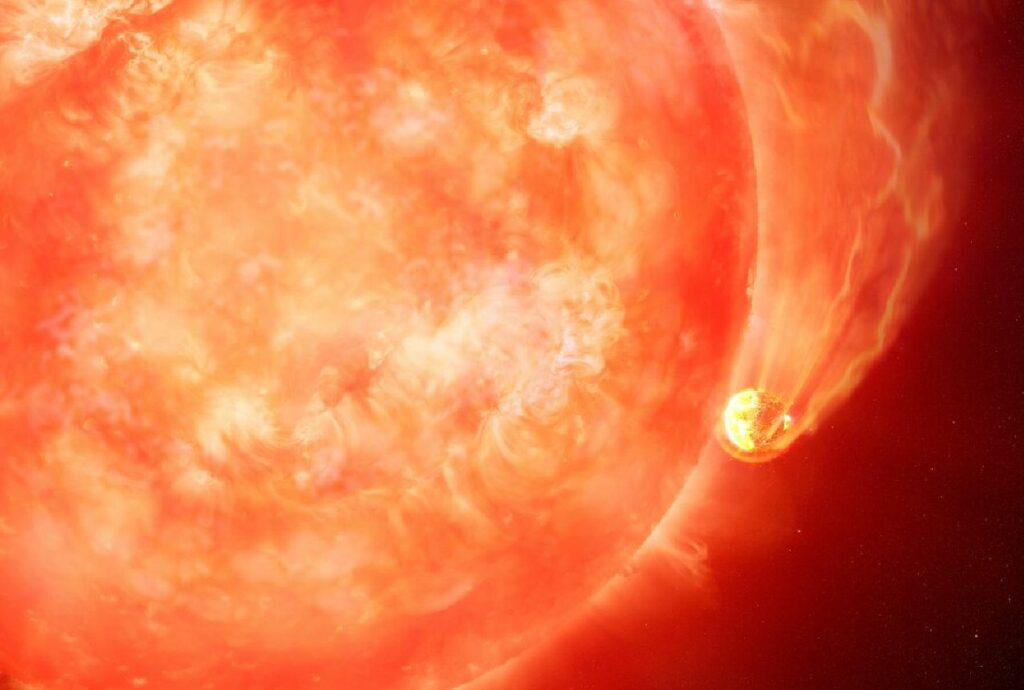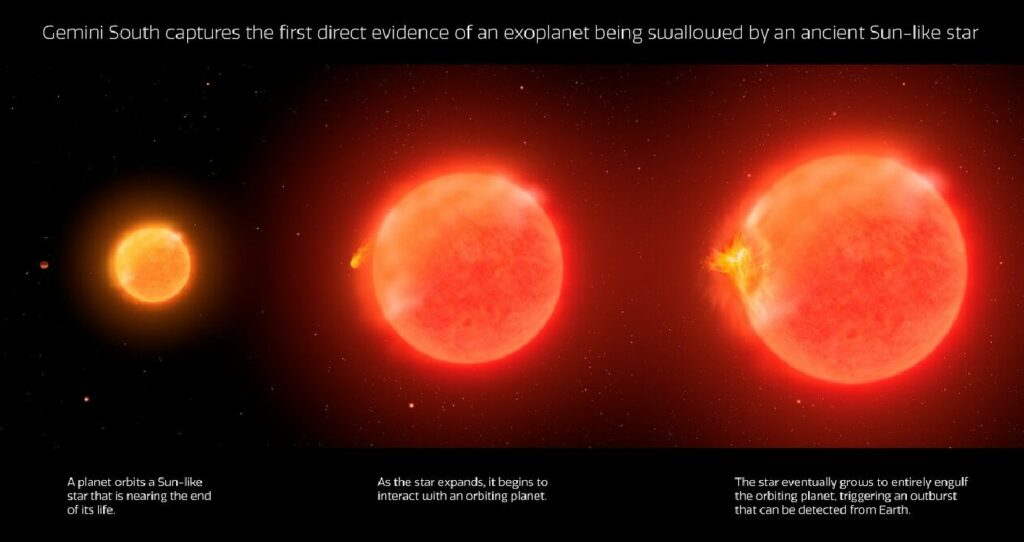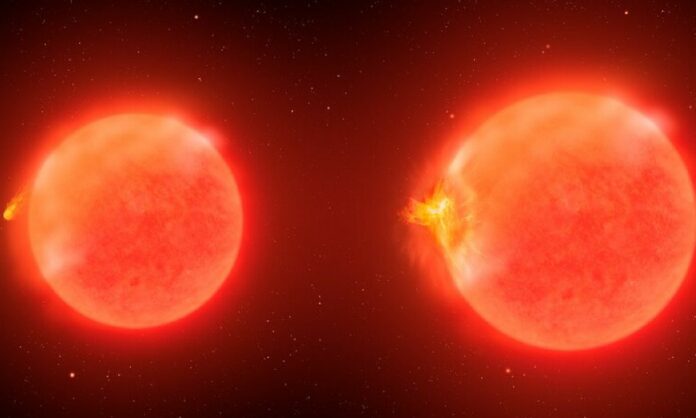Never-Before-Seen Event: Astronomers Stunned as Star Gobbles Up a Planet, Offering Glimpse into Earth’s Future
A new study published in Nature presents the first-ever direct evidence of a star consuming a planet, providing a glimpse into Earth’s future demise.
Astronomers have made a groundbreaking discovery as they witness a star consuming a planet, offering insight into Earth’s eventual fate. As stars approach the end of their lives, they expand and engulf anything in their path, including planets.
While scientists have previously detected clues of stars consuming planets, this marks the first time they have observed it happening.
The study, published in Nature, involved scientists from MIT, Harvard University, Caltech, and other institutions, who observed an outburst from a star in our galaxy, some 12,000 light-years away, which became more than 100 times brighter over just 10 days before quickly fading away.
Surprisingly, after the intense white-hot flash, astronomers detected a subsequent cooler and more prolonged signal. Based on this unique combination, scientists concluded that the only plausible explanation was the engulfment of a neighboring planet by the star.
“We were seeing the end-stage of the swallowing,” comments lead author Kishalay De.
Regarding the fate of the planet that vanished, experts estimate it to have been a Jupiter-sized celestial body, characterized by intense heat, that gradually approached the dying star, succumbing to the irresistible gravitational pull and eventually being engulfed by its atmosphere and core.
A parallel destiny awaits Earth, but the cataclysmic event is not anticipated for another five billion years. At that point, as the sun reaches the end of its life cycle, it will exhaust its fuel, causing the solar system’s inner planets, including Earth, to be consumed by its expanding fiery presence.
“We are seeing the future of the Earth,” De adds. “If some other civilization was observing us from 10,000 light-years away while the sun was engulfing the Earth, they would see the sun suddenly brighten as it ejects some material, then form dust around it, before settling back to what it was.”
The research paper has been co-authored by esteemed scientists from MIT, including Deepto Chakrabarty, Anna-Christina Eilers, Erin Kara, Robert Simcoe, Richard Teague, and Andrew Vanderburg, along with colleagues from other renowned institutions such as Caltech and the Harvard and Smithsonian Center for Astrophysics.

Hot and Cold: Unraveling the Mystery
In a remarkable turn of events, the team made the outburst discovery in May 2020, but it took them another year to piece together its true nature.
The initial signal appeared during a thorough analysis of data obtained from the Zwicky Transient Facility (ZTF), a survey conducted at Caltech’s Palomar Observatory. ZTF scans the sky for stars that undergo rapid fluctuations in brightness, which could signify various stellar phenomena like supernovae or gamma-ray bursts.
While sifting through the ZTF data, De had been searching for signs of eruptions in stellar binaries—systems where two stars orbit each other and occasionally transfer mass, causing momentary brightness increases. However, one night, De stumbled upon a star that astoundingly brightened by a factor of 100 over the span of a week, defying any previous stellar outburst he had witnessed.
Seeking more data to pinpoint the source, De turned to observations of the same star taken by the Keck Observatory in Hawaii. By employing spectroscopic measurements of starlight, scientists can unravel a star’s chemical composition.
To De’s bewilderment, the findings posed more questions than answers. While most binaries emit stellar material like hydrogen and helium as one star erodes the other, this particular source did not exhibit such characteristics. Instead, De encountered indications of “peculiar molecules” that can solely exist under extremely cold temperatures.
“These molecules are only seen in stars that are very cold,” De adds. “And when a star brightens, it usually becomes hotter. So, low temperatures and brightening stars do not go together.”
“This was a planet, crashing into its star”
After careful analysis, it became evident that the signal did not originate from a stellar binary system. De chose to exercise patience, eagerly anticipating further insights. Approximately a year later, De and the research team scrutinized fresh observations of the star using an infrared camera situated at the Palomar Observatory. In the infrared spectrum, astronomers can detect indications of colder substances, which stand in contrast to the intense white-hot emissions typical of binaries and other extraordinary stellar occurrences.
“That infrared data made me fall off my chair,” De adds. “The source was insanely bright in the near-infrared.”
After the star’s initial burst of heat, it continued to emit colder energy for the following year. This frigid material is believed to be gas expelled from the star, which then condensed into dust with temperatures low enough to be detected in the infrared spectrum. These findings led researchers to consider the possibility that the star was undergoing a process of merging with another star, rather than experiencing a supernova explosion.

However, upon further analysis of the data, and in conjunction with measurements from NASA’s infrared space telescope, NEOWISE, the team made an even more thrilling discovery. By compiling the data, they estimated the total energy released by the star since its initial outburst, and the result was astonishingly small — merely 1/1,000th the magnitude of any previously observed stellar merger.
“That means that whatever merged with the star has to be 1,000 times smaller than any other star we’ve seen,” De points out. “And it’s a happy coincidence that the mass of Jupiter is about 1/1,000 the mass of the sun. That’s when we realized: This was a planet, crashing into its star.”
With all the necessary pieces in place, the team of scientists was finally able to provide an explanation for the initial outburst. They deduced that the bright and hot flash was probably the final moments of a Jupiter-sized planet being sucked into the dying star’s expanding atmosphere. As the planet spiraled inward towards the core of the star, the outer layers of the star were expelled, settling as cold dust over the following year.
“For decades, we’ve been able to see the before and after,” De adds. “Before, when the planets are still orbiting very close to their star, and after, when a planet has already been engulfed, and the star is giant. What we were missing was catching the star in the act, where you have a planet undergoing this fate in real-time. That’s what makes this discovery really exciting.”
Source: 10.1038/s41586-023-05842-x
Image Credit: International Gemini Observatory/NOIRLab/NSF/AURA/M. Garlick/M. Zamani
